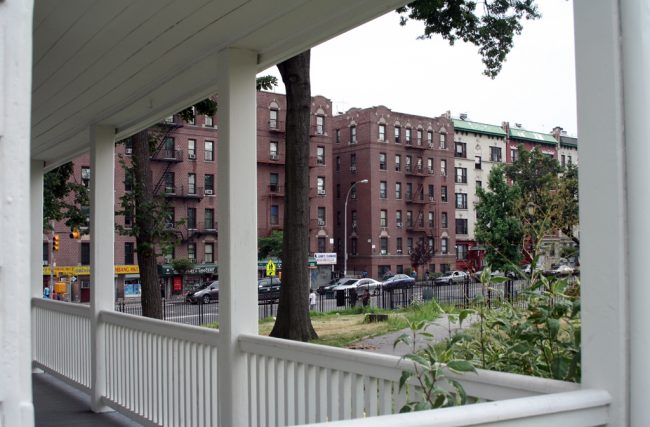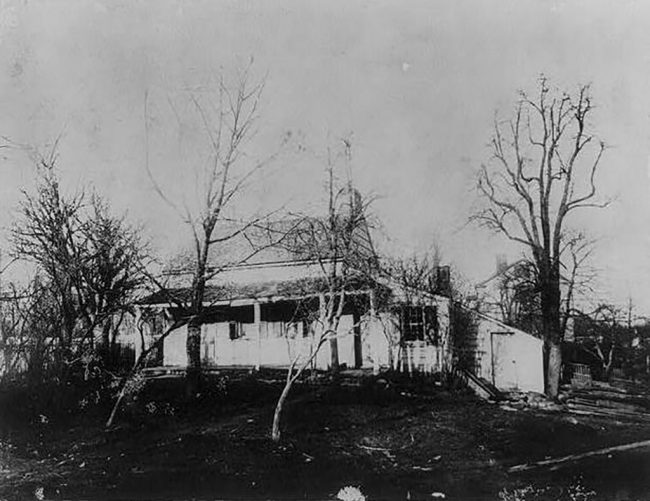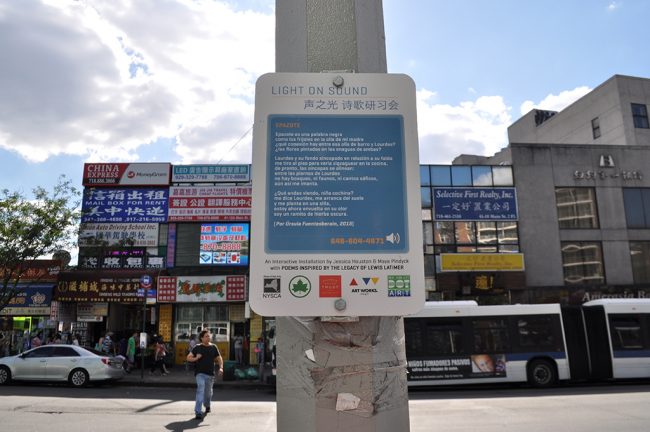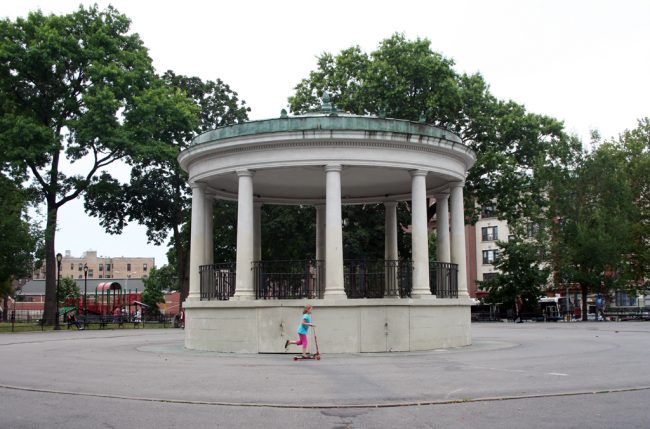
We are celebrating 15 years — and counting — of stories that are deeply researched and deeply felt, that build a historical record of what the city has been.
We are celebrating 15 years — and counting — of stories that are deeply researched and deeply felt, that build a historical record of what the city has been.

The white clapboard cottage sticks out among the dense grid of brick-walled tenements that surround Poe Park today. | Photo by Samuel Freeman
There are more historic house museums than Starbucks in the United States. Is that too many? A survey conducted by the National Trust for Historic Preservation concluded that more than half of the country’s estimated 15,000 historic house museums receive no more than 5,000 visitors a year — fewer than 15 per day.
And so perceptive administrators are asking themselves an existential question: who cares about this stuff, other than us?
At Poe Cottage in the Bronx, the former home of Edgar Allan Poe, Angel Hernandez thinks he has an answer. As an educator with the Bronx Historical Society, Hernandez has taken a decided stance on the side of the Uninterested Visitor. He, too, was not initially taken with Poe, and as a Puerto Rican American raised in the South Bronx, he understands his community’s hesitation to care about a dead, white celebrity of English language literature.
“When someone’s choosing between spending $5 either on a gallon of milk for their family or a trip to Poe Cottage, “ he says, “they’re almost always going to choose the milk.”
Poe Cottage was built in 1812, when this part of the Bronx was a scarcely populated village called Fordham. The house was moved two blocks south to Poe Park in 1913, was taken over by the New York City Parks Department in the late 1960s, and is currently managed by the Bronx Historical Society. Poe, his wife Virginia, and Virginia’s mother occupied the home from 1846 to 1849, when Poe died. Their rent was $100 per year.
The white clapboard cottage sticks out among the dense grid of brick-walled tenements that surrounds Poe Park today, but Hernandez argues the architectural contrast masks some common threads between Poe’s day and our own. “I’m not knocking historians, but every historic house has its own context. You have to interpret the house in the community in which it sits. The Bronx is poor and Poe was a poor man. It’s about connection,” he says. He wants students to leave thinking of Poe as an equal — a man who struggled financially and expressed himself through metered verse, 130 years before the borough gave birth to hip-hop. No need to speak English, either: Hernandez offers English and Spanish tours.

The house was originally located on Kingsbridge Road, but it was moved two blocks south to Poe Park in 1913. During Poe’s life, this area was called Fordham, NY. | Photo via Fred Berti
Hernandez isn’t the only one attempting to update a historic house within a community that has changed. Ran Yan, deputy director of the Lewis H. Latimer House in Flushing, Queens, has found ways to tailor the story of a black 19th-century inventor and poet to appeal to the surrounding Asian community. With the LatimerNOW Makerspace, initiated by the Historic House Trust of New York and funded by a grant from the New York Community Trust, Yan encourages visitors to use Latimer’s tinkering methods to understand his poetry.
Last summer, Latimer House’s Light on Sound exhibition, by the artists Maya Pindick and Jessica Houston, presented poems through sound sculptures. Neighborhood signs in Mandarin, English, and Spanish invited passers-by to call a phone number to hear the poems and record their own. Each call triggered an illumination of a light bulb in the house — a reference to Latimer’s invention of the carbon filament for the incandescent light bulb.

The Latimer House’s Light on Sound exhibition invited passersby to call a phone number to hear poems and record their own. | Photo courtesy of Ran Yan
In many cases, critics argue, house museums have fallen short of engaging the community. In The Anarchist’s Guide to Historic House Museums, Deborah E. Ryan and Franklin D. Vagnone argue that broadening these houses’ appeal is a key to their future. Their book, which was released in January, is a broadside against historic house programming practices. Told through a series of “rants,” the book gathers evidence that many house museums leave visitors feeling excluded. (Ryan, Vagnone, Hernandez, and Yan all appeared on a panel on the subject at the Museum of the City of New York in January.)
House museums, the book argues, have lost sight of the people they are meant to serve — the public. Place-based history, after all, is their distinguishing feature; seeing a Poe exhibit at a museum in Dallas shouldn’t be the same as walking through his home. The museums’ social and geographic context should be showcased. Although their funding might come primarily from wealthy donors and outside grants, the sustained success of the institution is impossible without the support of everyday attendees.
Most pressing, Hernandez believes, is drawing the attention of the neighboring community, where the median household income is between $14,000 and $35,000. If he catches their attention, the museum will gain the benefit of lasting local support.
Hernandez is not so interested in the original objects and furniture — or even the poetry. “You have to sell the man himself before you sell his works,” he claims. The easiest way for visitors to relate to Poe is through personal narrative. They want to know how Poe and his wife talked to each other, where they sat, and what they worried about. And then — and only then — do they want to take photos in his chair. At the top of the stairs to the second floor stands a life size cutout of Poe: “the Poe Selfie.”
With boards occupied by longtime trustees, often with deep but stubborn attachment to the sites, house directors sometimes find that an appeal to popular support is seen as a dilution of the historical narrative. In this view, forced pop parallels negate the effort to immerse the visitor in the chosen period of significance.
Here lies the tension between historical authenticity and mass appeal. If Hernandez had his way, he would replace roped-off period pieces with furniture that visitors can touch. As they wrote the book, Ryan and Vagnone hosted “Anarchist Workshops” with museum administrations to inspire a new way of understanding space. A reactionary participant sums up the traditionalist point of view: “If we VAGNON-IFY everything, nothing will be left to preserve.”
Historians who receive his tour have questioned Hernandez’s techniques. “Some people want to know why I do it the way I do,” he says. The answer is easy for him: an inspired visitor will spread the word (and photos) and bring in other visitors. A positive impression is the priority, and to achieve that, the tour guide has to know what the non-historian wants from a visit to a historic house museum: an entertaining story.

The bandstand that Angel Hernandez envisions as a stage for a “Hip-Hop at Poe” event. | Photo by Samuel Freeman
Hernandez has dreams for Poe Cottage. He dreams of an Edgar Allen Poe national tour for fans to visit all four Poe museum locations (in Philadelphia, Richmond, Baltimore, and New York). He dreams of free admission and audio tours in multiple languages. He wants to throw a “Hip-Hop at Poe” event in Poe Park. “Come on! It would be perfect. I want to see Jay-Z walking through the Poe house; Poe’s poetry next to Grandmaster Flash’s poetry.” He points to a bandstand across Poe Park where musicians could perform. The event would unite all of Poe Park and the surrounding community. He wants to convince a struggling community that Poe could be as much a personal hero as Bronx-born rapper Fat Joe.
“We hustle hard in the historic field of NYC,” he says with a half-smile. It’s a challenge getting an old house to captivate Bronxites focused on making ends meet. The trick is finding why they might care — and bridging neighborhood narratives from the past and present.
Allison Henry is a project assistant at Urban Omnibus and student of Urban Studies and Architecture at Columbia. She lives in Manhattan, by way of Philadelphia and Tampa.
The views expressed here are those of the authors only and do not reflect the position of The Architectural League of New York.